Nigella sativa-Manganese Ferrite-Reduced Graphene Oxide-Based Nanomaterial: A Novel Adsorbent for Water Treatment
Abstract
1. Introduction
2. Results and Discussion
2.1. Characterization Analysis
2.1.1. FTIR Analysis
2.1.2. X-ray Diffraction Analysis
2.1.3. Microscopic Analysis of NHC
2.1.4. Thermogravimetry Analysis of NHC
2.1.5. Nitrogen Physisorption Study
2.1.6. Zero-Point Charge Analysis
2.2. Results of Adsorption Studies
2.2.1. Adsorbent Amount and pH Effect
2.2.2. Temperature Effect, Thermodynamics, and Isotherms
2.2.3. Optimization of Contact Time, Adsorption Kinetics, and Mechanism
2.2.4. Regeneration and Reutilization
2.2.5. Comparative Analysis
3. Experimental
3.1. Materials and Methods
3.2. Synthesis of Reduced Graphene Oxide (rGO)
3.3. Preparation of NHC
3.4. Preparation of Adsorbate Stock Solution
3.5. Characterization and Instrumentations
3.6. Adsorption Experiments
3.7. Regeneration and Reutilization
4. Conclusions
Supplementary Materials
Author Contributions
Funding
Institutional Review Board Statement
Informed Consent Statement
Data Availability Statement
Acknowledgments
Conflicts of Interest
Sample Availability
References
- Xue, H.; Gao, X.; Seliem, M.K.; Mobarak, M.; Dong, R.; Wang, X.; Fu, K.; Li, Q.; Li, Z. Efficient adsorption of anionic azo dyes on porous heterostructured MXene/biomass activated carbon composites: Experiments, characterization, and theoretical analysis via advanced statistical physics models. Chem. Eng. J. 2023, 451, 138735. [Google Scholar] [CrossRef]
- Shehnaz; Prasher, I.B.; Ahmad, N.; Ahmed, M.; Raghuwanshi, S.; Kumar, V.; Siddiqui, S.I.; Oh, S. Live Biomass of Rigidoporus vinctus: A Sustainable Method for Decoloration and Detoxification of Dyes in Water. Microorganisms 2023, 11, 1435. [Google Scholar] [CrossRef]
- Siddiqui, S.I.; Allehyani, E.S.; Al-Harbi, S.A.; Hasan, Z.; Abomuti, M.A.; Rajor, H.K.; Oh, S. Investigation of Congo Red Toxicity towards Different Living Organisms: A Review. Processes 2023, 11, 807. [Google Scholar] [CrossRef]
- Mulushewa, Z.; Dinbore, W.T.; Ayele, Y. Removal of methylene blue from textile waste water using kaolin and zeolite-x synthesized from Ethiopian kaolin. Environ. Anal. Health Toxicol. 2021, 6, e2021007-0. [Google Scholar] [CrossRef] [PubMed]
- Xue, H.; Wang, X.; Xu, Q.; Dhaouadi, F.; Sellaoui, L.; Seliem, M.K.; Lamine, A.B.; Belmabrouk, H.; Bajahzar, A.; Bonilla-Petriciolet, A.; et al. Adsorption of methylene blue from aqueous solution on activated carbons and composite prepared from an agricultural waste biomass: A comparative study by experimental and advanced modeling analysis. Chem. Eng. J. 2022, 430, 132801. [Google Scholar] [CrossRef]
- Echabbi, F.; Hamlich, M.; Harkati, S.; Jouali, A.; Safi, M. Photocatalytic degradation of methylene blue by the use of titanium-doped Calcined Mussel Shells CMS/TiO2. J. Environ. Chem. Eng. 2019, 7, 103293. [Google Scholar] [CrossRef]
- Jamwal, H.S.; Kumari, S.; Chauhan, G.S.; Reddy, N.S.; Ahn, J.H. Silica-polymer hybrid materials as methylene blue adsorbents. J. Environ. Chem. Eng. 2017, 5, 103–113. [Google Scholar] [CrossRef]
- Mekkawi, D.M.E.; Ibrahim, F.A.; Selim, M.M. Removal of methylene blue from water using zeolites prepared from Egyptian kaolins collected from different sources. J. Environ. Chem. Eng. 2016, 4, 1417–1422. [Google Scholar] [CrossRef]
- Oladoye, P.O.; Ajiboye, T.O.; Omotola, E.O.; Oyewola, O.J. Methylene blue dye: Toxicity and potential elimination technology from wastewater. Results Eng. 2022, 16, 100678. [Google Scholar] [CrossRef]
- Siddiqui, S.I.; Ravi, R.; Rathi, G.; Tara, N.; Ul-Islam, S.; Chaudhry, S.A. Decolorization of textile wastewater using composite materials. In Nano Materials in the Wet Processing of Textiles; Islam, S.U., Butola, B.S., Eds.; John Wiley & Sons, Inc.: New York, NY, USA, 2018; pp. 187–218. [Google Scholar]
- Jayalakshmi, R.; Jeyanthi, J.; Sidhaarth, K.R.A. Versatile application of cobalt ferrite nanoparticles for the removal of heavy metals and dyes from aqueous solution. Environ. Nanotechnol. Monit. Manag. 2022, 17, 100659. [Google Scholar] [CrossRef]
- Wabaidur, S.M.; Khan, M.A.; Siddiqui, M.R.; Otero, M.; Jeon, B.H.; Alothman, Z.A.; Hakami, A.A.H. Oxygenated functionalities enriched MWCNTs decorated with silica coated spinel ferrite—A nanocomposite for potentially rapid and efficient de-colorization of aquatic environment. J. Mol. Liq. 2020, 317, 113916. [Google Scholar] [CrossRef]
- Sun, J.; Wu, T.; Liu, Z.; Shao, B.; Liang, Q.; He, Q.; Luo, S.; Pan, Y.; Zhao, C.; Huang, D. Peroxymonosulfate activation induced by spinel ferrite nanoparticles and their nanocomposites for organic pollutants removal: A review. J. Clean. Prod. 2022, 346, 131143. [Google Scholar] [CrossRef]
- Jacintha, M.A.; Umapathy, V.; Neeraja, P.; Rex Jeya Rajkumar, S. Synthesis and comparative studies of MnFe2O4 nanoparticles with different natural polymers by sol–gel method: Structural, morphological, optical, magnetic, catalytic and biological activities. J. Nanostruct. Chem. 2017, 7, 375–387. [Google Scholar] [CrossRef]
- Alaqarbeh, M.; Khalili, F.I.; Kanoun, O. Manganese ferrite (MnFe2O4) as potential nanosorbent for adsorption of uranium(VI) and thorium(IV). J. Radioanal. Nucl. Chem. 2020, 323, 515–537. [Google Scholar] [CrossRef]
- Khan, M.A.; Otero, M.; Kazi, M.; Alqadami, A.A.; Wabaidur, S.M.; Siddiqui, M.R.; Alothman, Z.R.; Sumbul, S. Unary and binary adsorption studies of lead and malachite green onto a nanomagnetic copper ferrite/drumstick pod biomass composite. J. Hazard. Mater. 2019, 365, 759–770. [Google Scholar] [CrossRef]
- Kumar, S.; Nair, R.R.; Pillai, P.B.; Gupta, S.N.; Iyengar, M.A.R.; Sood, A.K. Graphene oxide–MnFe2O4 magnetic nanohybrids for efficient removal of lead and arsenic from water. ACS Appl. Mater. Interfaces 2014, 6, 17426–17436. [Google Scholar] [CrossRef] [PubMed]
- Goscianska, J.; Nowicki, P.; Nowak, I.; Pietrzak, R. Thermal analysis of activated carbons modified with silver metavanadate. Thermochim. Acta 2012, 541, 42–48. [Google Scholar] [CrossRef]
- Yusuf, M.; Kumar, M.; Khan, M.A.; Sillanpää, M.; Arafat, H. A review on exfoliation, characterization, environmental and energy applications of graphene and graphene-based composites. Adv. Colloid Interface Sci. 2019, 273, 102036. [Google Scholar] [CrossRef] [PubMed]
- Yusuf, M.; Elfghi, F.M.; Zaidi, S.A.; Abdullah, E.C.; Khan, M.A. Applications of graphene and its derivatives as an adsorbent for heavy metal and dye removal: A systematic and comprehensive overview. RSC Adv. 2015, 5, 50392–50420. [Google Scholar] [CrossRef]
- Dogra, I.; Kumar, B.R.; Etika, K.C.; Chavali, M.; Khalifa, A.S.; Gharib, A.F.; El Askary, A. Environmentally friendly low-cost graphene oxide-cellulose nanocomposite filter for dye removal from water. J. King Saud Univ. Sci. 2022, 34, 102122. [Google Scholar] [CrossRef]
- Li, Y.; Dong, X.; Zhao, L. Application of magnetic chitosan nanocomposites modified by graphene oxide and polyethyleneimine for removal of toxic heavy metals and dyes from water. Int. J. Biol. Macromol. 2021, 192, 118–125. [Google Scholar] [CrossRef] [PubMed]
- Vo, T.S.; Vo, T.T.B.C. Organic dye removal and recycling performances of graphene oxide-coated biopolymer sponge. Prog. Nat. Sci. Mater. Int. 2022, 32, 634–642. [Google Scholar] [CrossRef]
- Abd-Elhamid, A.I.; Kamoun, E.A.; El-Shanshory, A.A.; Soliman, H.M.A.; Aly, H.F. Evaluation of graphene oxide-activated carbon as effective composite adsorbent toward the removal of cationic dyes: Composite preparation, characterization and adsorption parameters. J. Mol. Liq. 2019, 279, 530–539. [Google Scholar] [CrossRef]
- Xiong, S.; Wu, Z.; Li, Z. Facile fabrication of robust, versatile, and recyclable biochar-graphene oxide composite monoliths for efficient removal of different contaminants in water. Chemosphere 2022, 287, 132418. [Google Scholar] [CrossRef] [PubMed]
- Alshareef, S.A.; Alqadami, A.A.; Khan, M.A.; Alanazi, H.S.; Siddiqui, M.R.; Jeon, B.H. Simultaneous co-hydrothermal carbonization and chemical activation of food wastes to develop hydrochar for aquatic environmental remediation. Bioresour. Technol. 2022, 347, 126363. [Google Scholar] [CrossRef] [PubMed]
- Alshareef, S.A.; Otero, M.; Alanazi, H.S.; Siddiqui, M.R.; Khan, M.A.; Alothman, Z.A. Upcycling olive oil cake through wet torrefaction to produce hydrochar for water decontamination. Chem. Eng. Res. Des. 2021, 170, 13–22. [Google Scholar] [CrossRef]
- Liao, M.; Kelley, S.; Yao, Y. Generating Energy and Greenhouse Gas Inventory Data of Activated Carbon Production Using Machine Learning and Kinetic Based Process Simulation. ACS Sustain. Chem. Eng. 2020, 8, 1252–1261. [Google Scholar] [CrossRef]
- Tara, N.; Siddiqui, S.I.; Bach, Q.V.; Chaudhry, S.A. Reduce graphene oxide-manganese oxide-black cumin-based hybrid composite (rGO-MnO2/BC): A novel material for water remediation. Mater. Today Comm. 2020, 25, 101560. [Google Scholar] [CrossRef]
- Podder, M.S.; Majumder, C.B. Sequestering of As(III) and As(V) from wastewater using a novel neem leaves/MnFe2O4 composite biosorbent. Int. J. Phytoremediat. 2016, 18, 1237–1257. [Google Scholar] [CrossRef]
- Yuvaraja, G.; Su, M.; Chen, D.Y. Impregnation of magnetic—Momordica charantia leaf powder into chitosan for the removal of U(VI) from aqueous and polluted wastewater. Int. J. Biol. Macromol. 2020, 149, 127–139. [Google Scholar] [CrossRef]
- Yuvaraja, G.; Zheng, N.C.; Pang, Y. Removal of U(VI) from aqueous and polluted water solutions using magnetic Arachis hypogaea leaves powder impregnated into chitosan macromolecule. Int. J. Biol. Macromol. 2020, 148, 887–897. [Google Scholar] [CrossRef] [PubMed]
- Narasimharao, K.; Al-Thabaiti, S.; Rajor, H.K.; Mokhtar, M.; Alsheshri, A.; Alfaifi, S.Y.; Siddiqui, S.I.; Abdulla, N.K. Fe3O4@date seeds powder: A sustainable nanocomposite material for wastewater treatment. J. Mater. Res. Technol. 2022, 18, 3581–3597. [Google Scholar] [CrossRef]
- Abdulla, N.K.; Siddiqui, S.I.; Fatima, B.; Sultana, R.; Tara, N.; Hashmi, A.A.; Ahmad, R.; Mohsin, M.; Nirala, R.K.; Linh, N.T.; et al. Silver based hybrid nanocomposite: A novel antibacterial material for water cleansing. J. Clean. Prod. 2020, 284, 124746. [Google Scholar] [CrossRef]
- Gibert, O.; Lefèvre, B.; Fernández, M.; Bernat, X.; Paraira, M.; Calderer, M.; Martínez-Lladó, X. Characterising biofilm development on granular activated carbon used for drinking water production. Water Res. 2013, 47, 1101–1110. [Google Scholar] [CrossRef]
- Bogino, P.C.; Oliva Mde, L.; Sorroche, F.G.; Giordano, W. The role of bacterial biofilms and surface components in plant-bacterial associations. Int. J. Mol. Sci. 2013, 14, 15838–15859. [Google Scholar] [CrossRef] [PubMed]
- Thabede, P.M.; Shooto, N.D. Application of black cumin (Nigella sativa L.) seeds for the removal of metal ions and methylene blue from aqueous solutions. Chem. Eng. 2022, 9, 2013419. [Google Scholar] [CrossRef]
- Thabede, P.M.; Shooto, N.D.; Xaba, T.; Naidoo, E.B. Magnetite Functionalized Nigella Sativa Seeds for the Uptake of Chromium(VI) and Lead(II) Ions from Synthetic Wastewater. Adsorp. Sci. Technol. 2021, 2021, 6655227. [Google Scholar] [CrossRef]
- Ajala, O.J.; Tijani, M.T.; Bankole, J.O.; Abdulkareem, A.S. A critical review on graphene oxide nanostructured material: Properties, Synthesis, characterization and application in water and wastewater treatment. Environ. Nanotech. Monit. Manag. 2022, 18, 100673. [Google Scholar] [CrossRef]
- Saravani, A.Z.; Nadimi, M.; Aroon, M.A.; Pirbazari, A.E. Magnetic TiO2/NiFe2O4/reduced graphene oxide nanocomposite as a recyclable photocatalyst for photocatalytic removal of methylene blue under visible light. J. Alloys Compd. 2019, 803, 291–306. [Google Scholar] [CrossRef]
- Zhang, L.; Guo, J.; Huang, X.; Wang, W.; Sun, P.; Li, Y.; Han, J. Functionalized biochar-supported magnetic MnFe2O4 nanocomposite for the removal of Pb(II) and Cd(II). RSC Adv. 2019, 9, 365–376. [Google Scholar] [CrossRef]
- Haque, S.U.; Nasar, A.; Inamuddin Rahman, M.M. Applications of chitosan (CHI)-reduced graphene oxide (rGO)-polyaniline (PAni) conducting composite electrode for energy generation in glucose biofuel cell. Sci. Rep. 2020, 10, 10428. [Google Scholar] [CrossRef]
- El-Maghrabi, N.; El-Borady, O.M.; Hosny, M.; Fawzy, M. Catalytic and medical potential of a phyto-functionalized reduced graphene oxide–gold nanocomposite using willow-leaved knotgrass. ACS Omega 2021, 6, 34954–34966. [Google Scholar] [CrossRef] [PubMed]
- Seki, T.; Chiang, K.-Y.; Yu, C.-C.; Yu, X.; Okuno, M.; Hunger, J.; Nagata, Y.; Bonn, M. The Bending Mode of Water: A Powerful Probe for Hydrogen Bond Structure of Aqueous Systems. J. Phys. Chem. Lett. 2020, 11, 8459–8469. [Google Scholar] [CrossRef] [PubMed]
- Tara, N.; Siddiqui, S.I.; Nirala, R.K.; Abdulla, N.K.; Chaudhry, S.A. Synthesis of antibacterial, antioxidant and magnetic Nigella sativa-graphene oxide based nanocomposite BC-GO@Fe3O4 for water treatment. Colloid Interface Sci. Commun. 2020, 37, 100281. [Google Scholar] [CrossRef]
- Khan, M. Adsorption of methylene blue onto natural Saudi Red Clay: Isotherms, kinetics and thermodynamic studies. Mater. Res. Express 2020, 7, 055507. [Google Scholar] [CrossRef]
- Wang, H.; Yao, Q.; Wang, C.; Fan, B.; Sun, Q.; Jin, C.; Xiong, Y.; Chen, Y. A simple, one-step hydrothermal approach to durable and robust superparamagnetic, superhydrophobic and electromagnetic wave-absorbing wood. Sci. Rep. 2016, 6, 35549. [Google Scholar] [CrossRef] [PubMed]
- Choudhry, A.; Sharma, A.; Siddiqui, S.I.; Ahamad, I.; Sajid, M.; Khan, T.A.; Chaudhry, S.A. Origanum vulgare manganese ferrite nanocomposite: An advanced multifunctional hybrid material for dye remediation. Environ. Res. 2023, 220, 115193. [Google Scholar] [CrossRef]
- Yang, X.; Chen, C.; Li, J.; Zhao, G.; Ren, X.; Wang, X. Graphene oxide-iron oxide and reduced graphene oxide-iron oxide hybrid materials for the removal of organic and inorganic pollutants. RSC Adv. 2012, 2, 8821–8826. [Google Scholar] [CrossRef]
- Bertran, A.; Sandoval, S.; Oró-Solé, J.; Sánchez, À.; Tobias, G. Particle size determination from magnetization curves in reduced graphene oxide decorated with monodispersed superparamagnetic iron oxide nanoparticles. J. Colloid Interface Sci. 2020, 566, 107–119. [Google Scholar] [CrossRef]
- Jasinski, J.B.; Ziolkowska, D.; Michalska, M.; Lipinska, L.; Korona, K.P.; Kaminska, M. Novel graphene oxide/manganese oxide nanocomposites. RSC Adv. 2013, 3, 22857–22862. [Google Scholar] [CrossRef]
- Saha, D.; Visconti, M.C.; Desipio, M.M.; Thorpe, R. Inactivation of antibiotic resistance gene by ternary nanocomposites of carbon nitride, reduced graphene oxide and iron oxide under visible light. Chem. Eng. J. 2020, 382, 122857. [Google Scholar] [CrossRef]
- Munir, S.; Daood, S.S.; Nimmo, W.; Cunliffe, A.M.; Gibbs, B.M. Thermal analysis and devolatilization kinetics of cotton stalk, sugar cane bagasse and shea meal under nitrogen and air atmospheres. Bioresour. Technol. 2009, 100, 1413–1418. [Google Scholar] [CrossRef] [PubMed]
- Zhang, H.; Xu, M.; Wang, H.-J.; Lei, D.; Qu, D.; Zhai, Y.-J. Adsorption of copper by aminopropyl functionalized mesoporous delta manganese dioxide from aqueous solution. Colloids Surfaces A Physicochem. Eng. Asp. 2013, 435, 78–84. [Google Scholar] [CrossRef]
- Fatima, B.; Siddiqui, S.I.; Ahmed, R. Green synthesis of f-CdWO4 for photocatalytic degradation and adsorptive removal of Bismarck Brown R dye from water. Water Resour. Ind. 2019, 22, 100119. [Google Scholar] [CrossRef]
- Fatima, B.; Siddiqui, S.; Ahmed, R.; Chaudhry, S.A. Preparation of functionalized CuO nanoparticles using Brassica rapa leave extract for water purification. Desalin. Water Treat. 2019, 164, 192–205. [Google Scholar] [CrossRef]
- Fatima, B.; Alwan, B.A.; Siddiqui, S.I.; Ahmad, R.; Almesfer, M.; Khanna, M.K.; Mishra, R.; Ravi, R.; Oh, S. Facile Synthesis of Cu-Zn Binary Oxide Coupled Cadmium Tungstate (Cu-ZnBO-Cp-CT) with Enhanced Performance of Dye Adsorption. Water 2021, 13, 3287. [Google Scholar] [CrossRef]
- Abdulla, N.K.; Siddiqui, S.I.; Tara, N.; Hashmi, A.A.; Chaudhry, S.A. Psidium guajava leave-based magnetic nanocomposite γ-Fe2O3@GL: A green technology for methylene blue removal from water. J. Environ. Chem. Eng. 2019, 7, 103423. [Google Scholar] [CrossRef]
- Siddiqui, S.I.; Rathi, G.; Chaudhry, S.A. Acid washed black cumin seed powder preparation for adsorption of methylene blue dye from aqueous solution: Thermodynamic, kinetic and isotherm studies. J. Mol. Liq. 2018, 264, 275–284. [Google Scholar] [CrossRef]
- Siddiqui, S.I.; Chaudhry, S.A. Nanohybrid composite Fe2O3-ZrO2/BC for inhibiting the growth of bacteria and adsorptive removal of arsenic and dyes from water. J. Clean. Prod. 2019, 223, 849–868. [Google Scholar] [CrossRef]
- Fatima, B.; Siddiqui, S.I.; Nirala, R.K.; Vikrant, K.; Kim, K.-H.; Ahmad, R.; Chaudhry, S.A. Facile green synthesis of ZnO–CdWO4 nanoparticles and their potential as adsorbents to remove organic dye. Environ. Pollut. 2020, 271, 116401. [Google Scholar] [CrossRef]
- Ahmed, R.; Siddiqui, S.I.; Al Alwan, B.; Almesfer, M.; Khanna, M.K.; Fatima, B.; Mishra, R.; Ansari, M.A.; Oh, S. Biodegradable acid based nanocomposite-CuO-ZnO-Ni(OH)2/PA: A novel material for water cleansing. J. Clean. Prod. 2022, 341, 130860. [Google Scholar] [CrossRef]
- Saha, P.; Chowdhury, S. Insight into adsorption thermodynamics. In Thermodynamics; Tadashi, M., Ed.; Intech Open: London, UK, 2011. [Google Scholar]
- Siddiqui, S.I.; Chaudhry, S.A. A review on graphene oxide and its composites preparation and their use for the removal of As3+and As5+ from water under the effect of various parameters: Application of isotherm, kinetic and thermodynamics. Process Saf. Env. Prot. 2018, 119, 138–163. [Google Scholar] [CrossRef]
- Priyadarshini, B.; Rath, P.P.; Behera, S.S.; Panda, S.R.; Sahoo, T.R.; Parhi, P.K. Kinetics, Thermodynamics and Isotherm studies on Adsorption of Eriochrome Black-T from aqueous solution using Rutile TiO2. IOP Conf. Ser. Mater. Sci. Eng. 2018, 310, 012051. [Google Scholar] [CrossRef]
- Siddiqui, S.I.; Manzoor, O.; Mohsin, M.; Chaudhry, S.A. Nigella sativa seed based nanocomposite-MnO2/BC: An antibacterial material for photocatalytic degradation, and adsorptive removal of Methylene blue from water. Environ. Res. 2019, 171, 328–340. [Google Scholar] [CrossRef]
- Zaidi, Z.; Siddiqui, S.I.; Fatima, B.; Chaudhry, S.A. Synthesis of ZnO nanospheres for water treatment through adsorption and photocatalytic degradation: Modelling and process optimization. Mater. Res. Bull. 2019, 120, 110584. [Google Scholar] [CrossRef]
- El-Khaiary, M.I. Kinetics and mechanism of adsorption of methylene blue from aqueous solution by nitric-acid treated water-hyacinth. J. Hazard. Mater. 2007, 147, 28–36. [Google Scholar] [CrossRef]
- Elkady, M.F.; Ibrahim, A.M.; Abd El-Latif, M.M. Assessment of the adsorption kinetics, 750 equilibrium and thermodynamic for the potential removal of reactive red dye using eggshell 751 biocomposite beads. Desalination 2011, 278, 412–423. [Google Scholar] [CrossRef]
- Arabkhani, P.; Javadian, H.; Asfaram, A.; Hosseini, S.N. A reusable mesoporous adsorbent for efficient treatment of hazardous triphenylmethane dye wastewater: RSM-CCD optimization and rapid microwave-assisted regeneration. Sci. Rep. 2021, 11, 22751. [Google Scholar] [CrossRef] [PubMed]
- Guo, D.; Li, Y.; Cui, B.; Hu, M.; Luo, S.; Ji, B.; Liu, Y. Natural adsorption of methylene blue by waste fallen leaves of Magnoliaceae and its repeated thermal regeneration for reuse. J. Clean. Prod. 2020, 267, 121903. [Google Scholar] [CrossRef]
- Aguedal, H.; Iddou, A.; Aziz, A.; Shishkin, A.; Ločs, J.; Juhna, T. Effect of thermal regeneration of diatomite adsorbent on its efficacy for removal of dye from water. Int. J. Environ. Sci. Technol. 2018, 16, 113–124. [Google Scholar] [CrossRef]
- Rathi, G.; Siddiqui, S.I.; Pham, Q.; Nam, V.T. Nigella sativa seeds based antibacterial composites: A sustainable technology for water cleansing—A review. Sustain. Chem. Pharm. 2020, 18, 100332. [Google Scholar] [CrossRef]
- Siddiqui, S.I.; Chaudhry, S.A. Nigella sativa plant based nanocomposite-MnFe2O4/BC: A 936 non-toxic, antibacterial material for water purification application. J. Clean. Prod. 2018, 200, 996–1008. [Google Scholar] [CrossRef]
- Sebeia, N.; Jabli, M.; Ghith, A.; Saleh, T.A. Eco-friendly synthesis of Cynomorium coccineum extract for controlled production of copper nanoparticles for sorption of methylene blue dye. Arab. J. Chem. 2020, 13, 4263–4274. [Google Scholar] [CrossRef]
- Hassan, W.; Farooq, U.; Ahmad, M.; Athar, M.; Khan, M.A. Potential biosorbent, Haloxylon recurvum plant stems, for the removal of methylene blue dye. Arab. J. Chem. 2017, 10, S1512–S1522. [Google Scholar] [CrossRef]
- Gupta, N.; Kushwaha, A.K.; Chattopadhyaya, M.C. Application of potato (Solanum tuberosum) plant wastes for the removal of methylene blue and malachite green dye from aqueous solution. Arab. J. Chem. 2016, 9 (Suppl. S1), S707–S716. [Google Scholar] [CrossRef]
- Siddiqui, S.I.; Zohra, F.; Chaudhry, S.A. Nigella sativa seed based nanohybrid composite-Fe2O3–SnO2/BC: A novel material for enhanced adsorptive removal of methylene blue from water. Environ. Res. 2019, 178, 108667. [Google Scholar] [CrossRef]
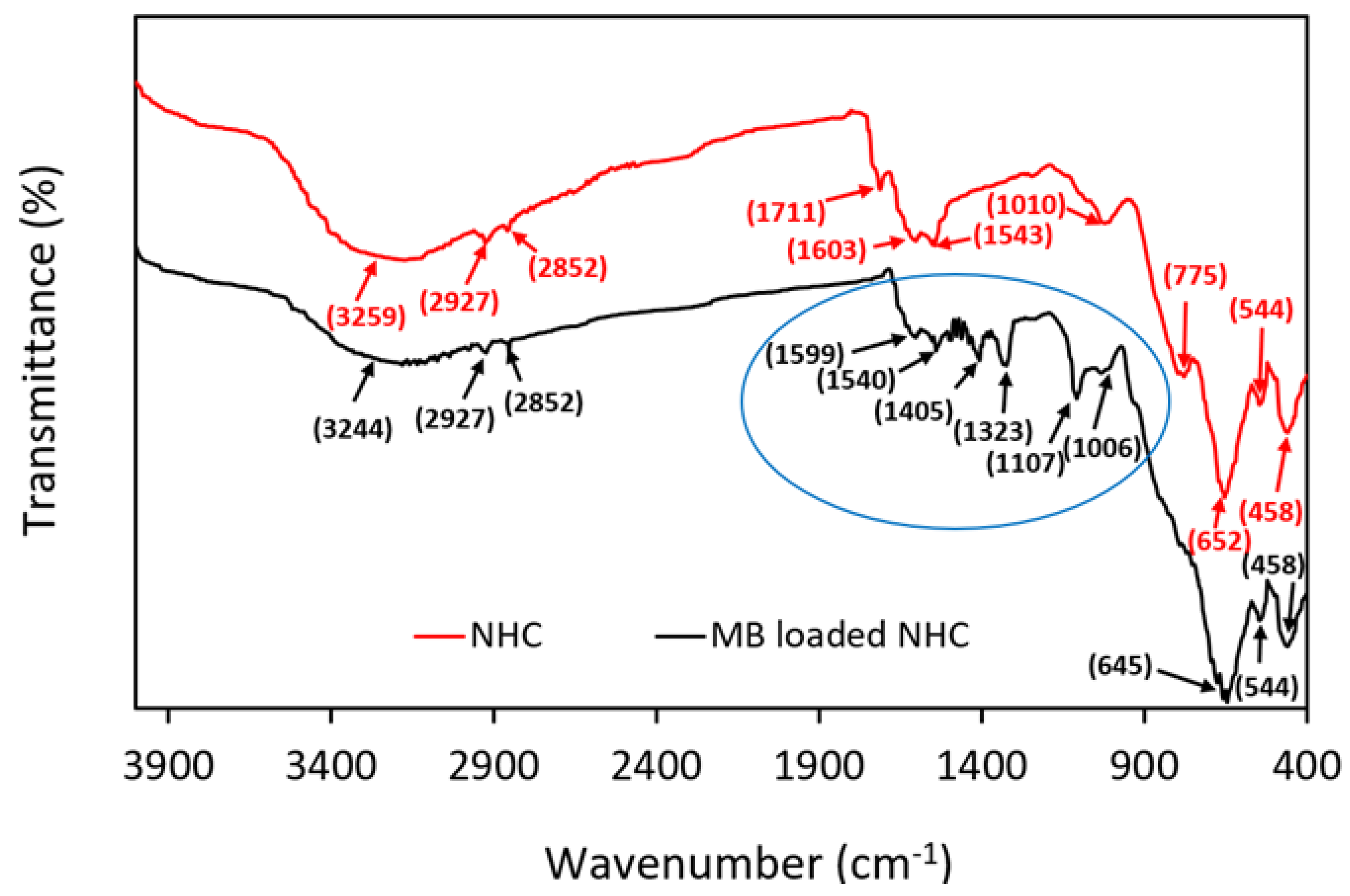
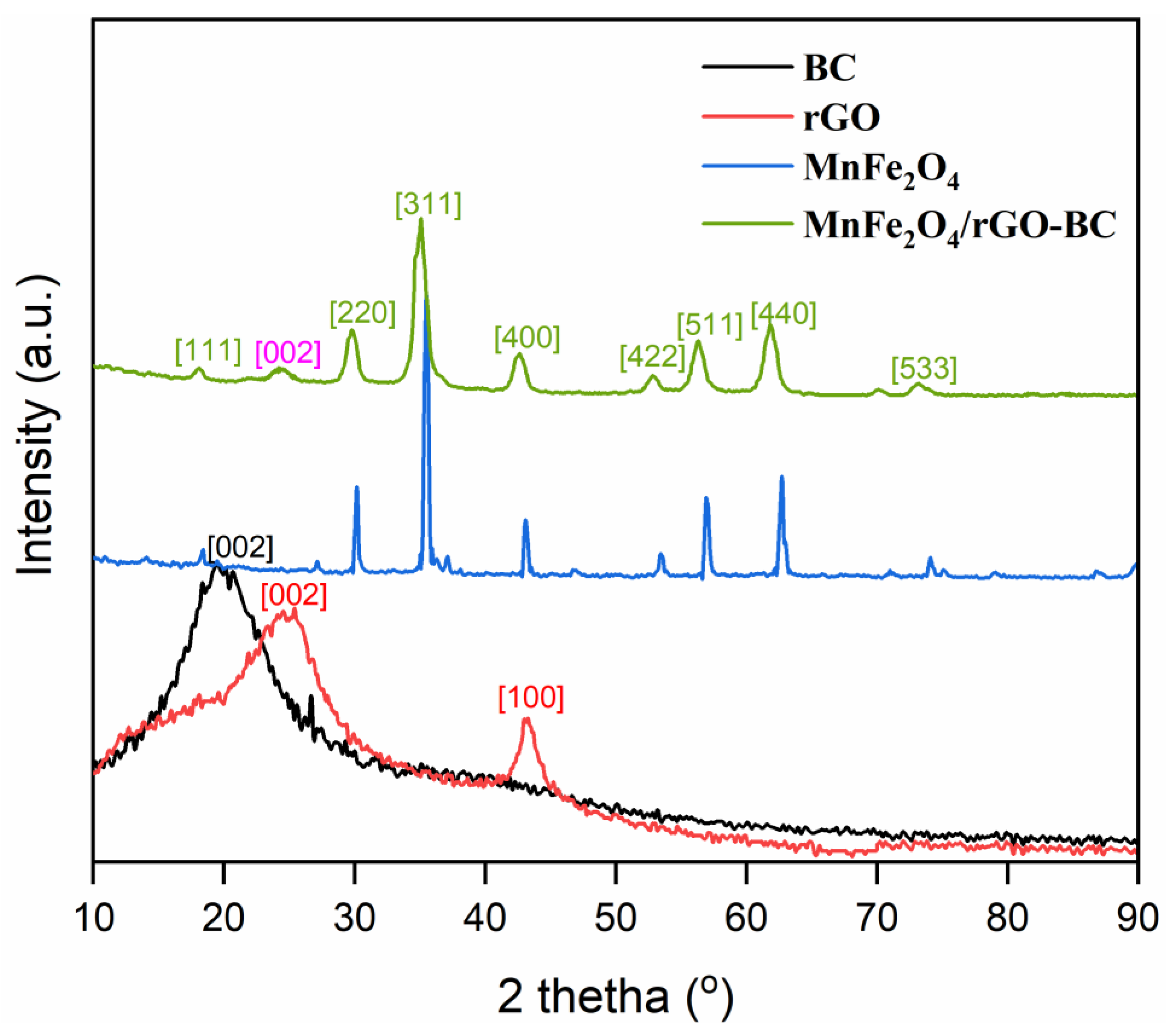
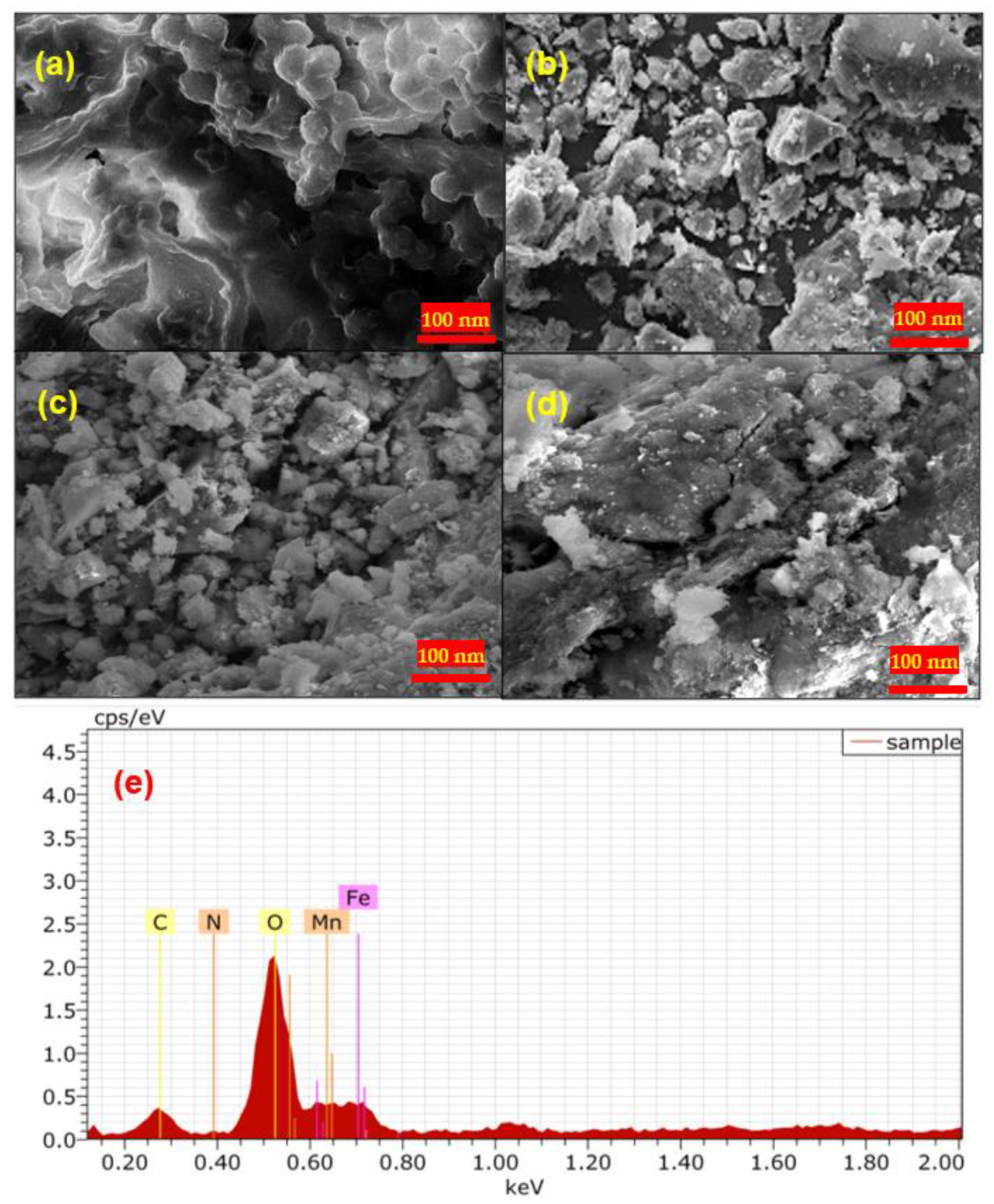

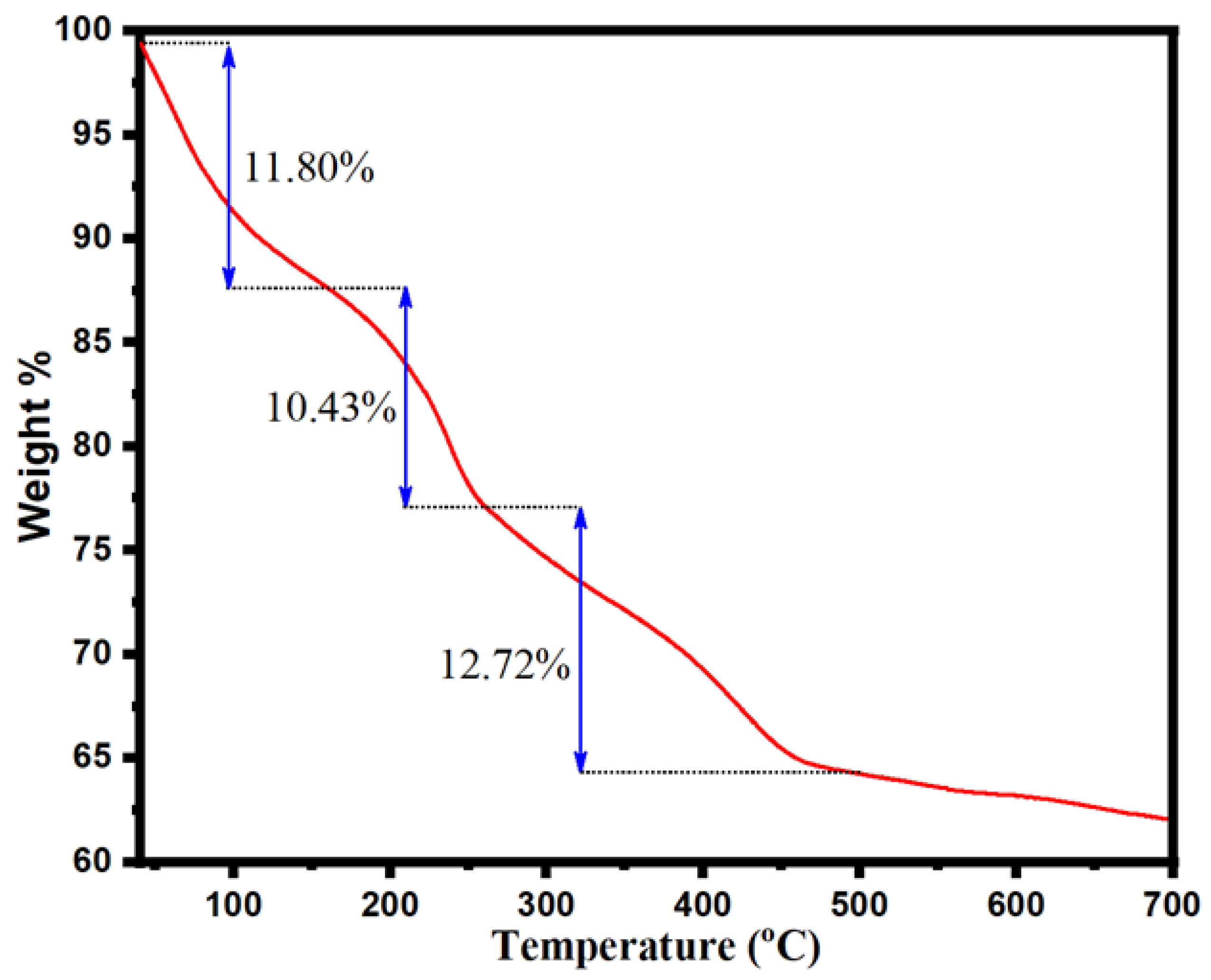

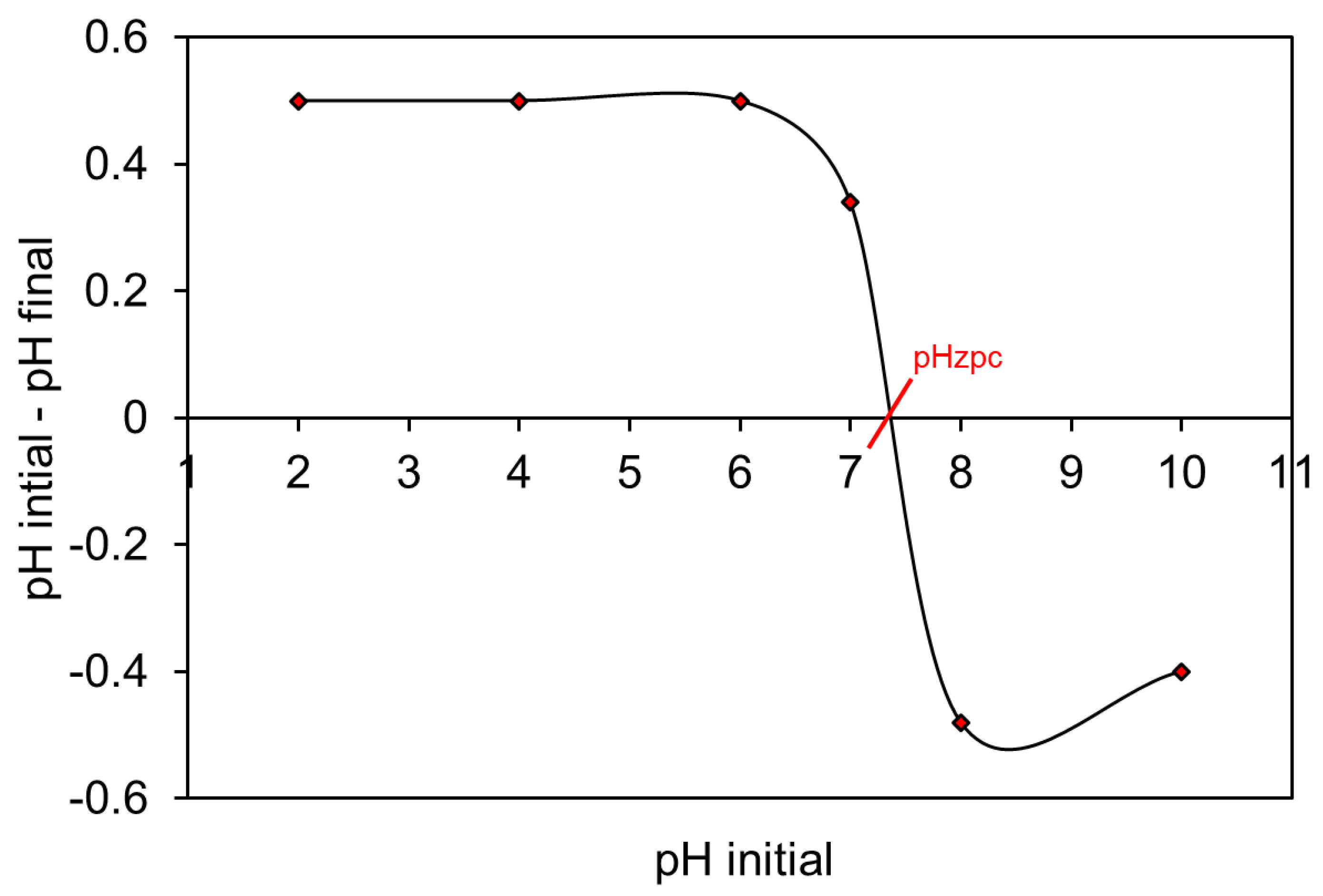

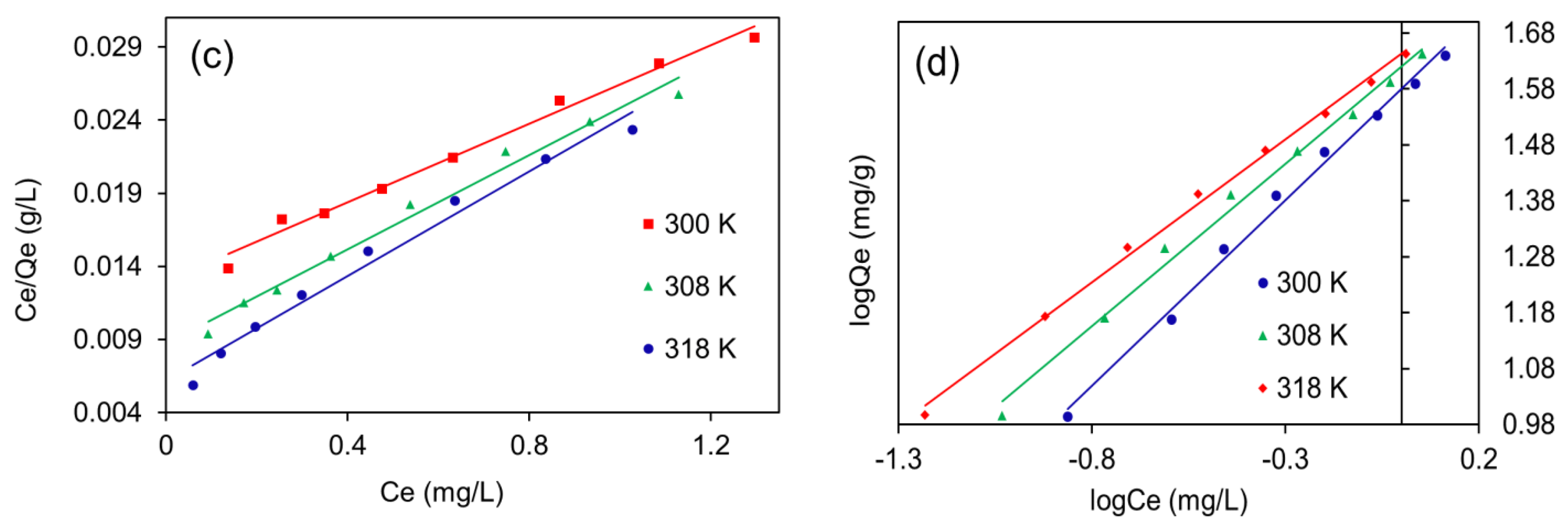
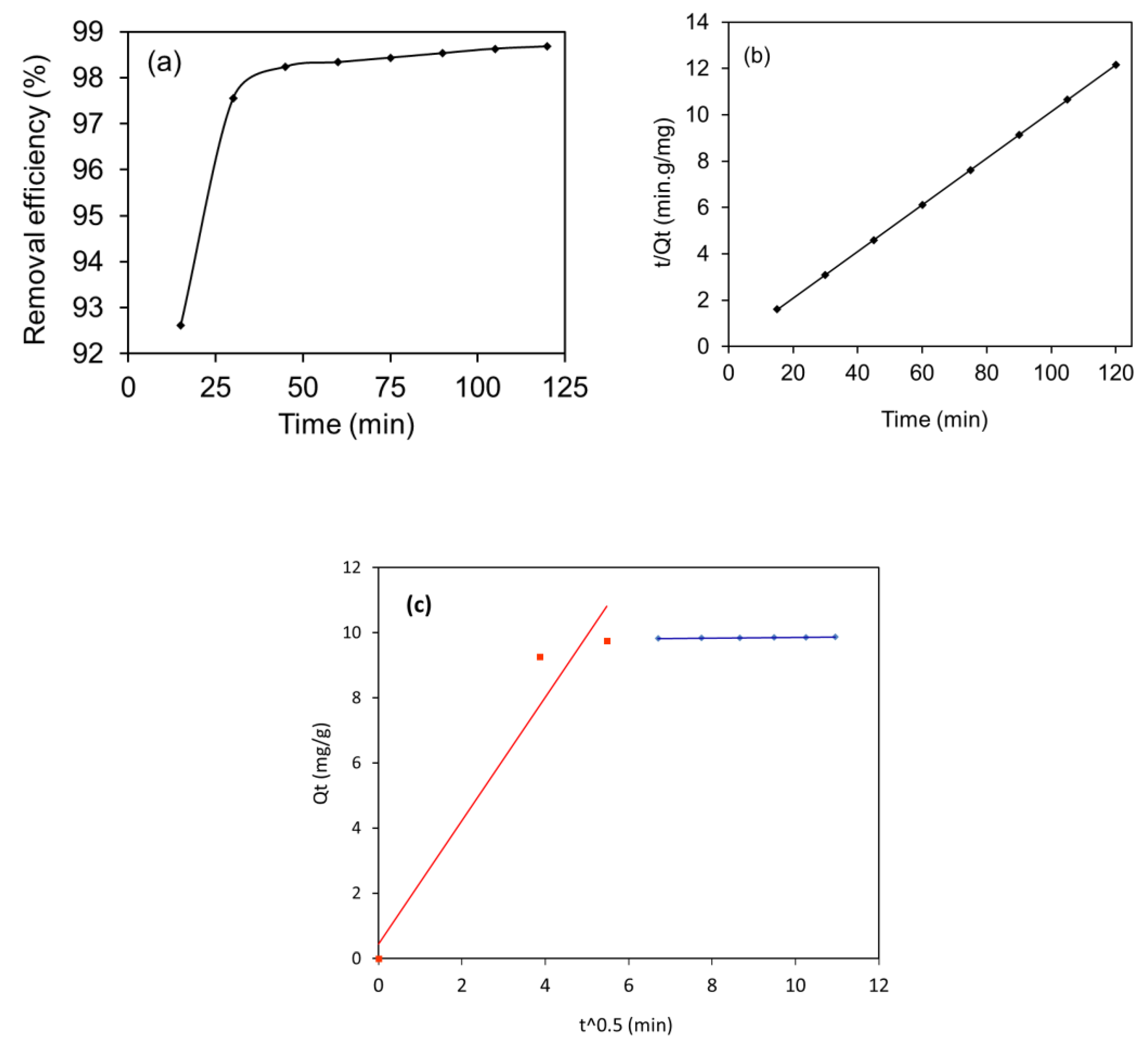

| Order | Wavenumber Assigned for BC * (cm−1) | Corr. Peaks | Wavenumber Assigned for rGO * (cm−1) | Corr. Peaks | Wavenumber Assigned for MnFe2O4/ rGO-BC (cm−1) | Corr. Peaks | Wavenumber Assigned for MB-Loaded MnFe2O4/ rGO-BC (cm−1) | Corr. Peaks |
|---|---|---|---|---|---|---|---|---|
| 1. | 3368 | -OH str. | 3316 | -OH str. | 3400–3250 | -OH str. | 3244 | -OH str. |
| 2. | 2922, 2853 | -C-H str. | 2917, 2855 | -C-H str. | 2927, 2852 | -C-H str. | 2927, 2852 | -C-H str. |
| 3. | 1706 | -C=O str. | 1589 | C=C str. | 1711 | -C=O str. | - | - |
| 4. | 1657 | Amide I | - | - | 1603 | Amide I | 1599 | Amide I |
| 5. | 1549 | Amide II | - | - | 1543 | Amide II | 1540 | Amide II |
| 6. | 1410 | -OH bend | - | - | - | 1405–1100 | Heterocyclic structure of MB | |
| 7. | 1259 | C-O str. | 1388 | -OH bend | 1010 | -OH bend | 1006 | -OH bend |
| 8. | 1100–700 | -C-O-C str. and/or C-C str. | 1090 | C-O str. and/or C-O-C str. | 544, 458 | M-O str. and/or M-O-M str. | 544, 458 | M-O str. and/or M-O-M str. |
| Temp (°C) | Langmuir | Freundlich | |||||
|---|---|---|---|---|---|---|---|
| Monolayer Adsorption Capacity, Qo (mg/g) | Langmuir Constant (Adsorption Intensity), b (L/mg) | Separation Constant, RL | Regression Coefficient, R2 | Freundlich Constant (Multilayer Adsorption Capacity), kF (mg/g) (L/mg)1/n | Freundlich Constant (Heterogeneity), n | Regression Coefficient, R2 | |
| 27 | 74.627 | 1.030 | 0.088 | 0.987 | 38.000 | 1.509 | 0.993 |
| 35 | 62.111 | 1.850 | 0.051 | 0.984 | 41.696 | 1.725 | 0.992 |
| 45 | 55.866 | 2.890 | 0.033 | 0.980 | 43.984 | 1.957 | 0.997 |
| Kinetics | Mathematical Equation | Parameters | Results Experimental Adsorption Capacity, Qt, exp = 9.804 mg/g |
|---|---|---|---|
| Pseudo-first-order | Pseudo-first-order constant, k1 (1/min) | 0.051 | |
| Pseudo-first-order adsorption capacity at time t, Qt, cal (mg/g) | 1.348 | ||
| Regression coefficient, R2 | 0.916 | ||
| Pseudo-second-order | Pseudo-second-order constant, k2 | 0.138 | |
| Pseudo-second-order adsorption capacity at time t, Qt, cal mg/g | 9.940 | ||
| Regression coefficient, R2 | 0.999 | ||
| Weber–Morris model | First (red) line, Kd1 | 1.893 | |
| First (red) line, C1 | 0.436 | ||
| Second (blue) line, K2 | 0.107 | ||
| Second (blue) line, C2 | 9.175 |
| Order | Adsorbent | Adsorbent Dose (g/L) | Contact Time (min) | Solution pH | Temperature (°C) | Initial Concentration (mg/L) | Maximum (Langmuir) Adsorption Capacity (mg/g) | Equilibrium Adsorption Capacity (mg/g) | Removal Efficiency (%) | PC (L/g) | Ref. |
|---|---|---|---|---|---|---|---|---|---|---|---|
| 1. | Ag-Ag2O/ZrO2/GL | 2.0 | 30.0 | 7.0 | 27.0 | 10.0 | 43.9 | 4.9 | 99.0 | 50.6 | [34] |
| 2. | Acid-washed black cumin seeds | 1.0 | 60.0 | 7.0 | 27.0 | 10.0 | 73.5 | 9.8 | 98.1 | 51.6 | [59] |
| 3. | MnFe2O4/BC | 3.0 | 45.0 | 7.0 | 27.0 | 10.0 | 10.1 | 3.3 | 99.4 | 52.6 | [74] |
| 4. | CuO | 2.5 | 30.0 | 6.0 | 22.0 | 25.0 | 64.0 | 5.5 | 54.7 | 0.5 | [75] |
| 5. | Haloxylon recurvum plant stems | 4.0 | 40.0 | 8.0 | 25.0 | 20.0 | 22.9 | 4.8 | 96.4 | 6.7 | [76] |
| 6. | Solanum tuberosum plant leaves | 2.0 | 24.0 | 7.0 | 30.0 | 10.0 | 52.6 | 3.9 | 79.0 | 1.9 | [77] |
| 7. | Fe2O3-SnO2/BC | 2.0 | 90.0 | 7.0 | 27.0 | 10.0 | 58.8 | 4.9 | 97.9 | 23.9 | [78] |
| 8. | MnFe2O4/rGO-BC | 1.0 | 45.0 | 7.0 | 27.0 | 10.0 | 74.6 | 9.9 | 98.6 | 72.0 | This study |
Disclaimer/Publisher’s Note: The statements, opinions and data contained in all publications are solely those of the individual author(s) and contributor(s) and not of MDPI and/or the editor(s). MDPI and/or the editor(s) disclaim responsibility for any injury to people or property resulting from any ideas, methods, instructions or products referred to in the content. |
© 2023 by the authors. Licensee MDPI, Basel, Switzerland. This article is an open access article distributed under the terms and conditions of the Creative Commons Attribution (CC BY) license (https://creativecommons.org/licenses/by/4.0/).
Share and Cite
Tara, N.; Abomuti, M.A.; Alshareef, F.M.; Abdullah, O.; Allehyani, E.S.; Chaudhry, S.A.; Oh, S. Nigella sativa-Manganese Ferrite-Reduced Graphene Oxide-Based Nanomaterial: A Novel Adsorbent for Water Treatment. Molecules 2023, 28, 5007. https://doi.org/10.3390/molecules28135007
Tara N, Abomuti MA, Alshareef FM, Abdullah O, Allehyani ES, Chaudhry SA, Oh S. Nigella sativa-Manganese Ferrite-Reduced Graphene Oxide-Based Nanomaterial: A Novel Adsorbent for Water Treatment. Molecules. 2023; 28(13):5007. https://doi.org/10.3390/molecules28135007
Chicago/Turabian StyleTara, Nusrat, May Abdullah Abomuti, F. M. Alshareef, Omeima Abdullah, Esam S. Allehyani, Saif Ali Chaudhry, and Seungdae Oh. 2023. "Nigella sativa-Manganese Ferrite-Reduced Graphene Oxide-Based Nanomaterial: A Novel Adsorbent for Water Treatment" Molecules 28, no. 13: 5007. https://doi.org/10.3390/molecules28135007
APA StyleTara, N., Abomuti, M. A., Alshareef, F. M., Abdullah, O., Allehyani, E. S., Chaudhry, S. A., & Oh, S. (2023). Nigella sativa-Manganese Ferrite-Reduced Graphene Oxide-Based Nanomaterial: A Novel Adsorbent for Water Treatment. Molecules, 28(13), 5007. https://doi.org/10.3390/molecules28135007





